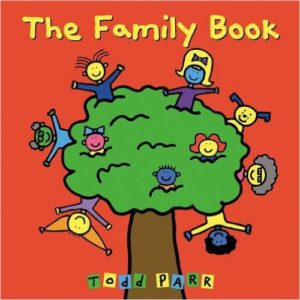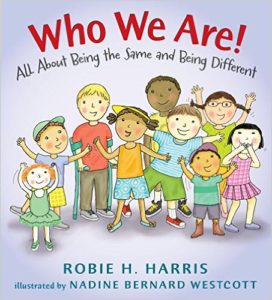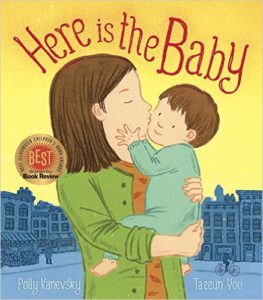
Play is an integral element in building family relationships and attachment. Through unstructured creative play, kids tap into inner resources and thoughts; often they unconsciously reveal concerns and beliefs. That’s why I love books that join creativity and play with reading. I’m particularly fond of books featuring boxes as a theme. Boxes springboard creativity and connection.
A box invites imaginations to soar. We’ve all watched kids opt to play with the box in preference to a gift because kids have an instinctual drive to create and fantasize. Check out this collection of books about boxes. They just may help you have fun together. Or, equally important, they may reveal thoughts and feelings they find difficult to express and share. These books invite conversation and fun.
In brief and jaunty rhyming text 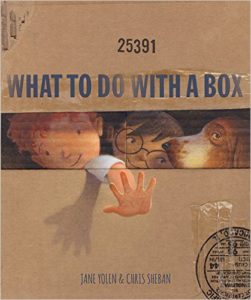 What to Do with a Box by Jane Yolen and illustrated by Chris Sheban declares, “A box is a wonder indeed. The only such magic that you’ll ever need.” The dreamy illustrations serve the theme well. Sheban draws the box with all the labels and markings still visible. Instead of limiting the fantasy element, this design choice reinforces the power of imagination to see beyond what is “real” and connect with what is possible.
What to Do with a Box by Jane Yolen and illustrated by Chris Sheban declares, “A box is a wonder indeed. The only such magic that you’ll ever need.” The dreamy illustrations serve the theme well. Sheban draws the box with all the labels and markings still visible. Instead of limiting the fantasy element, this design choice reinforces the power of imagination to see beyond what is “real” and connect with what is possible.
Whether launching on a solo journey or sharing the box’s magical potential, an empty box dares us to dream and rocket into a flight of fantasy.
Adoption-attuned Lens [bctt tweet=”Adoptees have intimate experience with imagining alternate worlds. ” username=”GayleHSwift”] They wonder what life might have been like had they not been adopted, or if they’d been adopted by a different family. A book like this invites kids and parents to share a box–and the fantasy it triggers. While journeying together, parents may be amazed at the variety of topics kids will explore. Let them take the lead and remain alert for seeds that can open adoption-connected conversations.
 A Box Can Be Many Things by Dana Meachen Rau and Illustrated by Paige Billin-Frye is part of the Rookie Reader Series which means it uses simple language. (Includes a list or 51 words.) It captures the same exuberant imaginative spirit paired with bright illustrations.
A Box Can Be Many Things by Dana Meachen Rau and Illustrated by Paige Billin-Frye is part of the Rookie Reader Series which means it uses simple language. (Includes a list or 51 words.) It captures the same exuberant imaginative spirit paired with bright illustrations.
Beginning readers will love the story line and the ability to read it themselves. Not only will this book spark their own flights of fancy, but it will also help build their reading skills. That’s a nice bonus!
Adoption-attuned Lens This book delivers a similar opportunity for adoptive families as the previous one. Parents can also suggest that they imagine the box as a time-traveling machine. Imagine the places and people that children might fantasize about visiting. As always, allow children to take the lead on any conversation that touches on “big stuff.” As parents we must ensure that kids know their questions and thoughts are welcomed but we must not force them into having them on our timeline.

How Dalia Put a Big Yellow Comforter inside a Tiny Blue Box by Linda Heller illustrated by Stacey Dressen McQueen takes a different spin on helping kids to realize the power of a box. This book comes from the PJ Library which “helps families explore the timeless values of Judaism.”
The story describes the Jewish practice of creating tzedakah boxes. The name means “I’m happy when you’re happy.” The actual translation is “fairness.”Children are encouraged to construct and decorate a box and then work to fill it with coins (or bills.). The money is then used to fund acts of charity and/or social justice.
Dalia tells her little brother that her tiny box holds a comforter, a butterfly bush and a cream pie. Brother is little but can easily see the box is too small to hold all these things. He decides Dalia’s box is magic.
Everyone in Dalia’s class makes their own tzedakah and works to find ways to earn money to fill them. Once they’ve collected enough, they buy the yellow comforter fabric and then decorate it themselves. The story concludes with the children presenting the blanket to an elderly woman. She is overjoyed by their generosity and artistry and appreciates the flowers the children plant in her garden. Mostly she enjoys their companionship. The children discover the real magic of the box is how it elicits their generosity and empathy.
Adoption-attuned Lens Some kids have a strong natural inclination to kindness and generosity. This book is a great fit for them. And, some children especially those adopted from foster care, may have a profound awareness of the needs and struggles of others (their birth families, perhaps, or neighbors, etc.) These children may enjoy the idea of performing acts of kindness and generosity.
[bctt tweet=”This activity may open some important and sensitive feelings. Stay alert for hints that kids wish to talk about hard things and or need reassurance about difficult histories.” username=”GayleHSwift”]
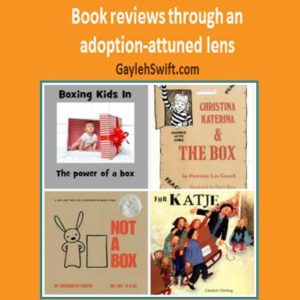 If this post intrigued you, please also read Boxing Kids In another book review blog post on boxes.
If this post intrigued you, please also read Boxing Kids In another book review blog post on boxes.


